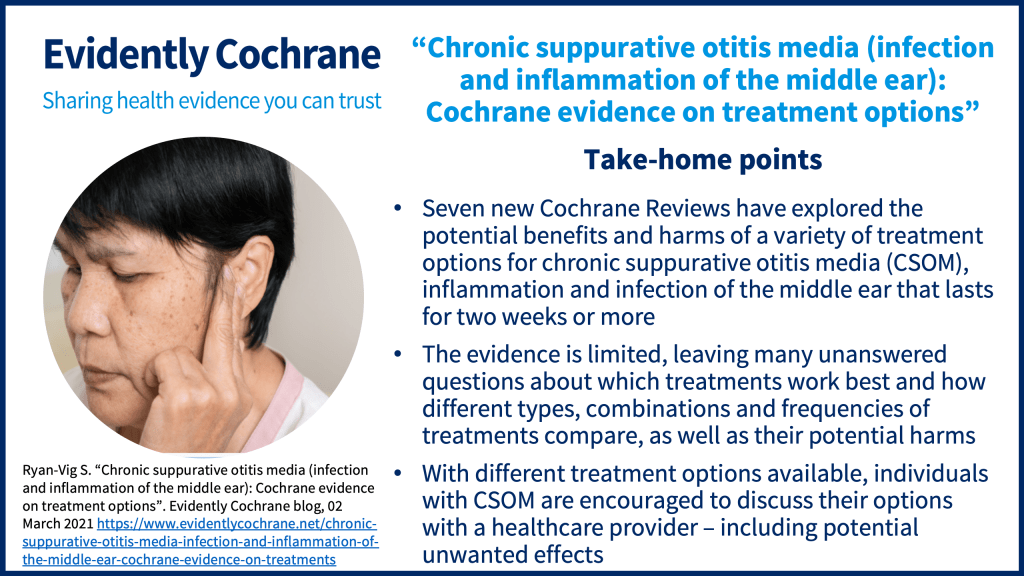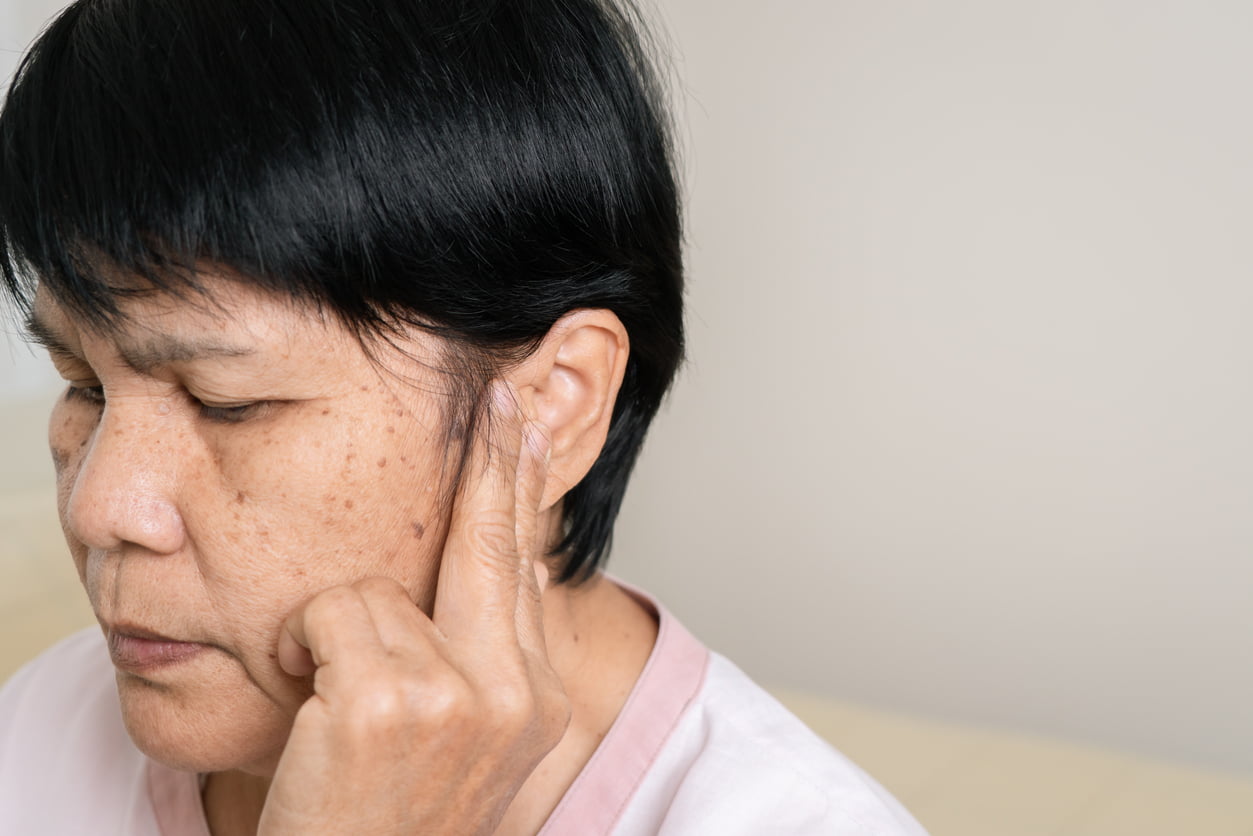In this blog for people affected by chronicA health condition marked by long duration, by frequent recurrence over a long time, and often by slowly progressing seriousness. For example, rheumatoid arthritis. suppurative otitis media, Selena Ryan-Vig, a Knowledge Broker at Cochrane UK, looks at the evidence from seven recent Cochrane ReviewsCochrane Reviews are systematic reviews. In systematic reviews we search for and summarize studies that answer a specific research question (e.g. is paracetamol effective and safe for treating back pain?). The studies are identified, assessed, and summarized by using a systematic and predefined approach. They inform recommendations for healthcare and research. exploring the benefits and harms of various treatmentSomething done with the aim of improving health or relieving suffering. For example, medicines, surgery, psychological and physical therapies, diet and exercise changes. options.
Page last checked 30 March 2023

Chronic suppurative otitis media (CSOM), also known as chronic otitis media, is an inflammation and infection of the middle ear that lasts for two weeks or more.
The main symptoms are ear discharge – pus that leaks out from a hole in the eardrum – and hearing loss. In rare cases, CSOM can lead to serious complications. Often, sufferers’ quality of life is affected. There is a clear need for effective, and safe, treatment options.
Between 2020 and 2021, seven Cochrane Reviews have been published, exploring the evidence on the benefits and risks of a variety of different, non-surgical treatments: topical antibiotics, systemic antibiotics, topical antibiotics with steroids, topical antiseptics and ear cleaning methods. These reviews have been brought together in a new Cochrane Special Collection: Chronic suppurative otitis media: effectiveness of non-surgical treatments.
CSOM is relatively rare in high-income countries, but is common in low- and middle-income countries. Surgical interventions are an option, but these Cochrane Reviews focus on medical management and the types of interventions that are more readily available in resource-poor settings – especially things like antiseptics and ear cleaning.
The authors of the reviews wanted to know whether these treatments are effective at stopping ear discharge, and whether they affect patients’ health-related quality of life and hearing. They also wanted to know whether the treatments cause pain, discomfort or irritation in the ear, unwanted effects such as dizziness or ear bleeding, or any serious complications.
Topical antibiotics
Topical antibiotics – meaning antibiotics put directly into the ear canal either as ear drops, ointments, sprays or creams – are the most commonly used treatment for CSOM. They aim to kill or stop the growth of the micro‐organisms that may be responsible for the infection.
Authors of a Cochrane Review on topical antibiotics for CSOM found 17 studies with over 2000 participants (people who took part in the studies). The studies compared a number of different types and combinations of antibiotics. The evidence was all low- and (mainly) very low-certaintyThe certainty (or quality) of evidence is the extent to which we can be confident that what the research tells us about a particular treatment effect is likely to be accurate. Concerns about factors such as bias can reduce the certainty of the evidence. Evidence may be of high certainty; moderate certainty; low certainty or very-low certainty. Cochrane has adopted the GRADE approach (Grading of Recommendations Assessment, Development and Evaluation) for assessing certainty (or quality) of evidence. Find out more here: https://training.cochrane.org/grade-approach, so the results are likely to change when better studies are available.
The bottom line:
- It is uncertain whether topical antibiotics improve the resolution of ear discharge in patients with CSOM
- However, there is some evidence that topical antibiotics may be more effective than placeboAn intervention that appears to be the same as that which is being assessed but does not have the active component. For example, a placebo could be a tablet made of sugar, compared with a tablet containing a medicine. for clearing up ear discharge at one to two weeks, and that topical antibiotics added to oral antibiotics may be better than oral antibiotics alone
- Which type of topical antibiotic is the most effective is uncertain
- It is important to consider whether topical antibiotics have any unwanted effects (harms), as it is understood that they can cause pain and itching for example. However, little is known about unwanted effects from the included studies, as they were poorly reported
You can read more in this Cochrane Clinical Answer: What are the benefits and harms of topical antibiotics for people with chronic suppurative otitis media?
Systemic antibiotics
CSOM may also be treated using antibiotics taken by mouth or given as an injection. These are known as systemic antibiotics (where the whole body is treated). They may be given alone or as well as topical antibiotics or other treatments such as steroids.
Authors of a Cochrane Review explored the benefits and risks of systemic antibiotics to treat CSOM and found 18 studies that involved over 2000 people with CSOM.
The bottom line:
- It is uncertain whether systemic antibiotics alone are better or worse than no treatment, and how they compare with each other
- When systemic antibiotics are given as well as topical antibiotics, they may make little to no difference to whether discharge clears up after one to two weeks. Other effects are uncertain
- The effects of systemic antibiotics added to other treatments (such as steroids) are also uncertain
- Evidence about possible unwanted effects is particularly limited
Topical versus systemic antibiotics
Authors of a Cochrane Review looked at whether topical antibiotics (put directly into the ear canal as ear drops or creams) work better than systemic antibiotics (taken by mouth or injected, to treat the whole body). They found six studies that involved 445 people with a limited amount of helpful evidence.
The bottom line:
- Taking quinolone (a type of antibiotics) as ear drops, may slightly increase the chances of ear discharge clearing up after one to two weeks, compared with taking quinoline by mouth. However, it is uncertain how they compare in terms of their effects on hearing, quality of life, or potential harms. The evidence is either too unreliable or the studies have not reported this information
- There is limited evidence available about different types of antibiotics
- More information is needed about unwanted effects.
Combining antibiotics with steroids
CSOM is commonly treated with a combination of antibiotics (to fight bacterial infection) and steroids (anti‐inflammation medicines) as a topical treatment (in the form of drops, sprays, ointments or creams put directly into the ear).
Authors of a Cochrane Review looking at the benefits and risks of combining antibiotics and steroids to treat CSOM found 17 studies with over 1901 people with CSOM. The studies covered a range of antibiotic plus steroid combinations, and compared them with either no treatment, the same antibiotic without steroids, different antibiotics without steroids, or a placebo (something which looks and seems like the treatment but does not have any active component).
The bottom line:
It is uncertain whether combining topical antibiotics with steroids is better or worse than no treatment or a placebo. This is either because the studies have not reported on important outcomesOutcomes are measures of health (for example quality of life, pain, blood sugar levels) that can be used to assess the effectiveness and safety of a treatment or other intervention (for example a drug, surgery, or exercise). In research, the outcomes considered most important are ‘primary outcomes’ and those considered less important are ‘secondary outcomes’. or the available evidence is very low-certainty.
However, there is some low-certainty evidence that:
- adding steroids to topical antibiotics may make little or no difference to clearing up ear discharge
- some types of topical antibiotics (without steroids) may be better than topical antibiotic/steroid combinations in clearing up discharge
It is uncertain how different types of antibiotics compare. Little is known about potential unwanted effects, because these were poorly reported.
You can read more in this Cochrane Clinical Answer: For people with chronic suppurative otitis media treated topically, how does an antibiotic (quinolone or non‐quinolone) plus steroid compare with a quinolone alone?
Topical antiseptics
Topical antiseptics (put directly into the ear as ear drops or as a powder) are sometimes used as a treatment for CSOM. Topical antiseptics aim to kill or stop the growth of the micro‐organisms that may be responsible for the infection.
Authors of a Cochrane Review on topical antiseptics for CSOM found five studies. It was unclear how many participants were included because most of the studies did not specify this. Different types of antiseptics were used: some used ear drops and some used powders.
The bottom line:
The existing evidence is all very low-certainty. It is uncertain how well antiseptics work in treating CSOM and we know little about their potential risks.
Topical antiseptics compared with antibiotics
Authors of a Cochrane Review comparing antibiotics versus topical antiseptics for CSOM found seven studies, which included 935 participants. These studies looked at four different types of topical antiseptics: acetic acid, aluminium acetate, boric acid and povidone-iodine. However, they were only able to draw conclusions about boric acid as the dataData is the information collected through research. for the others were limited.
The bottom line:
- Topical antibiotics are probably better than boric acid at resolving ear discharge at one to two weeks. There also may be less ear discomfort (pain, irritation and bleeding) and a bigger improvement in hearing with topical antibiotics compared with boric acid
- It is uncertain how antibiotics compare with other topical antiseptics because the evidence is very low-certainty
- Unwanted effects were not well reported
Ear cleaning
Different approaches can be used to clean the affected ears and remove discharge. These include:
- using cotton wool or tissue paper (dry mopping)
- sucking up material blocking the ear with a small device (usually done under a microscope)
- washing out the ear (irrigation)
However, authors of a Cochrane Review on ear cleaning for CSOM found only three studies with 431 people with CSOM. The studies only looked at dry mopping or suction and the evidence was all very low-certainty.
The bottom line
It is uncertain how effective ear cleaning is for people with CSOM, and whether it causes unwanted effects. Currently we know little about how different frequencies and techniques of ear cleaning compare. These are gaps which future research should address.
More gaps in the evidence than answers
Unfortunately, there currently seem to be more questions than answers about which treatments work best for treating CSOM, how different treatment types, frequencies and combinations of treatments compare, and their potential harms.
Dr Sam Mackeith, an Ear, Nose and Throat (ENT) Consultant and the Assistant Co-ordinating Editor of Cochrane ENT, says:
“Despite the lack of evidence regarding these treatments, many are used in routine clinical practice and are included within clinical practice guidelines for CSOM. Guidelines are developed even when the evidence is lacking and may rely on consensus expert opinion both regarding benefit and harms and balancing this with the riskA way of expressing the chance of an event taking place, expressed as the number of events divided by the total number of observations or people. It can be stated as ‘the chance of falling were one in four’ (1/4 = 25%). This measure is good no matter the incidence of events i.e. common or infrequent. of leaving CSOM untreated. It is also important to note that these non-surgical treatments often represent first line treatment, however, there are some surgical treatment options that can be considered if symptoms are persistent.”
More about hearing conditions
On this page Hearing conditions: evidence, experience and resources (March 2023) we share trustworthy evidence and resources about hearing conditions and highlight opportunities to take part in research. Our blogs help to set evidence in context and make it easy to understand, and often include reflections from people living with hearing conditions and from health professionals and researchers.
Selena Ryan-Vig has nothing to disclose.
Join in the conversation on Twitter with @CochraneUK and @CochraneENT or leave a comment on the blog.
Please note, we cannot give medical advice and do not publish comments that link to an individual’s page requesting donations or to commercial sites, or appear to endorse commercial products. We welcome diverse views and encourage discussion but we ask that comments are respectful and reserve the right to not publish any we consider offensive. Cochrane UK does not fact check – or endorse – readers’ comments, including any treatments mentioned.
People who comment on our blogs often have further questions, including about the effects of treatments. If you have a question about a health claim you have heard or read (e.g. does the use of petrol pumps spread COVID-19 (coronavirus disease)?) you can submit it to iHealthFacts, a fact-checking resource.


